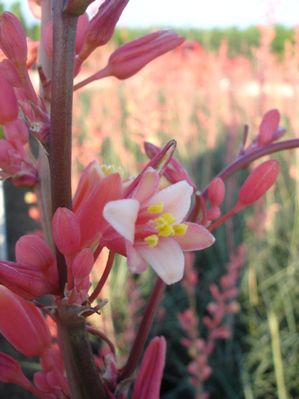Print This Page


The Red Yucca Bloom
Yucca, Red
Hesperaloe parviflora
Despite its common name, Red Yucca (Hesperaloe parviflora) is not a true yucca but shares similar drought-tolerant characteristics. This Texas native is prized for its striking, arching foliage and tall flower spikes that produce coral-red, tubular blooms from spring through fall. These flowers are a favorite among hummingbirds and other pollinators. The plant’s evergreen, grass-like leaves have a fine texture and develop a slight curl along the edges, making it a visually interesting choice for xeriscapes, rock gardens, and mass plantings.
Red Yucca is highly adaptable to Texas landscapes, tolerating extreme heat, drought, and poor soils. It thrives in full sun but can also perform well in part sun, though flowering may be reduced. It prefers well-draining soil and handles both rocky and sandy conditions with ease. While it is deer-resistant, occasional browsing may occur, especially in times of drought. This plant is also well-suited for use in borders, container plantings, and as an accent piece in desert or southwestern-style gardens.
Compared to true yuccas like Yucca rostrata or Yucca recurvifolia, Red Yucca grows 2 to 3 feet tall, 3 to 4 feet wide. The bloom stalks will reach up to 5 feet. Plant them 3 to 4 feet apart to avoid crowding. Red Yucca has a softer appearance due to its finer foliage and more flexible leaves. Unlike many yuccas, it does not develop a tall trunk and instead forms a dense, clumping rosette. Its flowers also differ in shape, being slender and tubular, whereas most yuccas produce broader, bell-shaped blooms. While Dasylirion species (Sotols) share some similarities in leaf structure, Red Yucca’s flowering habit and overall growth form set it apart in the landscape.
Red Yucca is highly cold-hardy, tolerating temperatures down to USDA Zone 5, making it an excellent choice for nearly all of Texas. It requires minimal winter care, though in extreme cold, mulching around the base can provide additional root protection. It does not require pruning, but spent flower stalks can be trimmed back in late winter to encourage fresh growth.
 |
Hummingbird Plant |
 |
Drought Tolerant |
 |
Xeriscape |
Flower Color:Coral-Pink
|
 |
Height:2-3 Feet
|
 |
Spread:3-4 Feet
|
 |
Spacing:3-4 Feet
|
Homeowner Growing & Maintenance Tips for Hesperaloe parviflora
Maintenance limited to removal of old flower stalks in winter.
USDA Hardiness Zone 5b
Available Sizes:
| Item |
Description |
| YUC-RED-05 |
#005 YUCCA, RED |

|
Characteristics & Attributes
|
Deer Tolerance
|
Exposure
| • |
Full Sun |
| • |
Full Sun to Part Shade |
|
Habit
|
Soil pH Preference
|
|
Water Needs
|
Texas Native
|
Tolerates Poor Drainage
|







